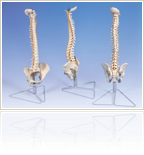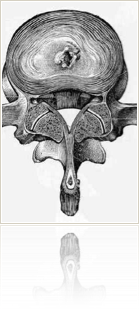




Scaffolds are used to give cells structure so that they can better function as a whole tissue. Scaffolds also serve to hold the construct in place during implantation. Once the adult MSCs have been differentiated and expanded into the appropriate cell types, they must be placed onto a scaffold. An ideal scaffold would allow cells to be organized in-vitro, be biocompatible to facilitate implantation, and degrade overtime as the tissue incorporates with the host [5]. As was seen in the last section, the environment of the cells can play a large role in their behavior, and so the choice of scaffold is very important.
When tissue engineering intervertebral discs, the most obvious requirement is that the cells be formed into a coherent shape with dimensions similar to intervertebral discs. The biocompatibility and degradation requirements can be met by using materials such as PLGA and/or collagen [5]. PLGA degrades via hydrolysis, and this rate can be controlled by changing the amount of lactic and glycolic acid present in the polymer. No toxins are released during this process, and the material invokes and very minimal immune response. PLGA is a polymer that can be formed into any desired shape, with any desired porosity. Thus, PLGA could be formed into a porous shape similar to that of an intervertebral disc. 

 Ideally, the center of the scaffold would have a different organization than the outer areas, to facilitate creation of the nucleus pulpous and annulus fibrosus. In addition, growth factors and nutrients could be imbedded into the scaffold to ensure appropriate cell growth and survival [5]. Additional ECM molecules such as collagen could also be incorporated into or on the scaffold to create a more natural environment. In fact, it has been shown that this can be done. Intervertebral disc cells from a mouse were isolated and placed onto a scaffold. An intervertebral disc almost as large an average human’s was successfully created and kept alive as a viable tissue construct [5].
Ideally, the center of the scaffold would have a different organization than the outer areas, to facilitate creation of the nucleus pulpous and annulus fibrosus. In addition, growth factors and nutrients could be imbedded into the scaffold to ensure appropriate cell growth and survival [5]. Additional ECM molecules such as collagen could also be incorporated into or on the scaffold to create a more natural environment. In fact, it has been shown that this can be done. Intervertebral disc cells from a mouse were isolated and placed onto a scaffold. An intervertebral disc almost as large an average human’s was successfully created and kept alive as a viable tissue construct [5].



Once the cells are seeded onto the scaffold, the intervertebral disc construct must be implanted. As will be seen in the next section, the use of PLGA material will facilitate incorporation of the tissue by the body due to the biodegradability of PLGA.






3. Scaffolds


